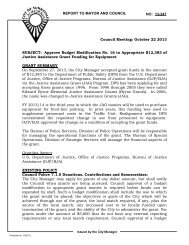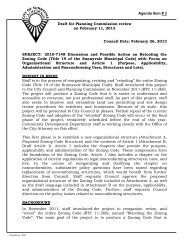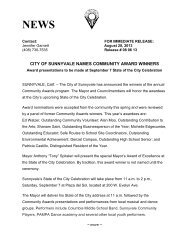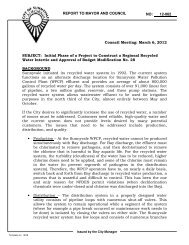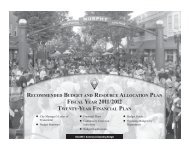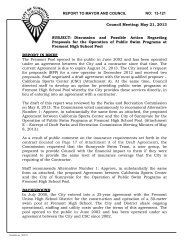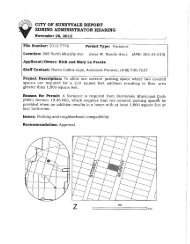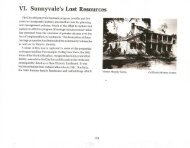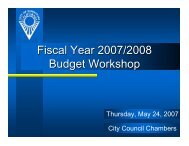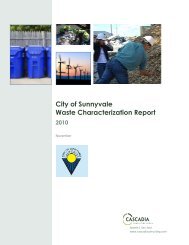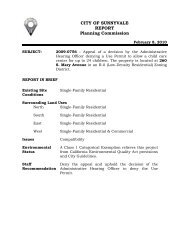Update to Green Building Progr - City of Sunnyvale - State of California
Update to Green Building Progr - City of Sunnyvale - State of California
Update to Green Building Progr - City of Sunnyvale - State of California
You also want an ePaper? Increase the reach of your titles
YUMPU automatically turns print PDFs into web optimized ePapers that Google loves.
2012-7019 – <strong>Update</strong> <strong>to</strong> <strong>Green</strong> <strong>Building</strong> <strong>Progr</strong>am (Residential and Public <strong>Building</strong>s)<br />
April 24, 2012<br />
Page 8 <strong>of</strong> 16<br />
Minimum Standards for New Residential Construction<br />
The minimum point level <strong>to</strong> achieve certification through Build It <strong>Green</strong> is 50<br />
points. <strong>Sunnyvale</strong>’s program currently requires a minimum <strong>of</strong> 70 points so that<br />
we provide a green building standard above the Build It <strong>Green</strong> minimum.<br />
Based on programs in other local jurisdictions, the 70 points is still at the high<br />
end, with the exception <strong>of</strong> San Francisco which requires 75 points for new<br />
residential construction. Almost half <strong>of</strong> the jurisdictions surveyed did not have<br />
any green building requirements beyond the <strong>State</strong> mandated CAL<strong>Green</strong>.<br />
While working with design pr<strong>of</strong>essionals and homeowners, staff has found that<br />
the general public is still a learning curve regarding the green building<br />
requirements. Most <strong>of</strong> the large residential developers are familiar with green<br />
building standards and techniques as they have greater resources <strong>to</strong> include<br />
green building principles in their building design and greater buying power <strong>to</strong><br />
source materials. Many <strong>of</strong> the smaller developers and many design<br />
pr<strong>of</strong>essionals focusing on individual single-family homes do not have a lot <strong>of</strong><br />
experience in this area. One likely reason for this is because the requirements<br />
are not standardized across the various jurisdictions, so many design<br />
pr<strong>of</strong>essionals who work primarily in other geographic areas have not<br />
experienced these green building standards.<br />
Staff received feedback from developers that the cost <strong>of</strong> the current Build It<br />
<strong>Green</strong> requirement (70 points) for new residential construction can range from<br />
$5,000 up <strong>to</strong> $15,000 per unit. While it is not easy <strong>to</strong> determine what the cost<br />
would be for additional points as circumstances vary from project <strong>to</strong> project, it<br />
was mentioned by developers that the first 70 points are fairly easy <strong>to</strong> achieve,<br />
but an additional 10 points would be more difficult and costly. This comment<br />
was also made by a Planning Commissioner.<br />
Staff recommends continued use <strong>of</strong> the generally accepted Build It <strong>Green</strong><br />
<strong>Progr</strong>am for new residential construction. With the objective <strong>of</strong> <strong>Sunnyvale</strong><br />
maintaining a leadership role in promoting green building construction, staff<br />
recommends increasing the minimum Build It <strong>Green</strong> point requirement from<br />
the current 70 points <strong>to</strong> 80 points for all new construction. This point level<br />
would be higher than the minimum required from Build It <strong>Green</strong> and would be<br />
the highest standards among local jurisdictions surveyed. Staff also<br />
recommends increasing the points required for the incentives <strong>to</strong> 110 (from<br />
100). Based on current trends in green building construction, staff believes the<br />
higher point requirement will challenge residential builders but will not pose a<br />
significant hardship.<br />
Minimum Standards for Residential Alterations<br />
Alterations <strong>to</strong> existing buildings include a wide range <strong>of</strong> projects from replacing<br />
a sewer line <strong>to</strong> a large addition. Many <strong>of</strong> the smaller projects do not affect<br />
enough change in an existing building <strong>to</strong> achieve a minimum green building



